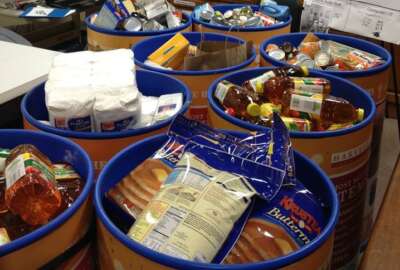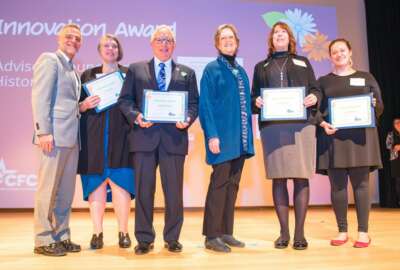
Feds dig deep, literally, to help others
The annual Feds Feed Families drive takes a national problem to the local level.
How’s this for a Fourth of July thought: Federal employees have delivered nearly 2.5 million pounds of groceries to food banks and pantries throughout the U.S. in the last few weeks.
You and I will be grilling steaks or maybe a Costco-sized hunk of salmon, and steaming ears of corn this weekend. I just spent $30 on a liter of Tequila so I can make margaritas. Meanwhile, according to the Agriculture Department’s Economic Research Service, 11.1% of U.S. households have — to use the contemporary vernacular — food insecurity for at least part of the year. That means they’re hungry, or they’re unsure where their next bag of groceries will come from.
Food insecurity isn’t confined to rural or inner city areas. In Montgomery County, Maryland, the Manna food bank provides 11,000 families with food.
To help, the annual Feds Feed Families drive is in full swing and runs through July. So I decided to make this column a salute to the feds and their agencies who are contributing.
If you want to see a great example of a data driven website, check out the dashboard engineered by the Agriculture Department’s chief information officer shop. Click on button #4 to see who’s giving and how much. Transportation Security Administration employees donated 990 pounds earlier this week. Interior’s Bureau of Safety and Environmental Enforcement delivered 900 pounds. USDA’s Agriculture Research Service recorded 13,000 pounds. Even employees a at U.S. Citizenship and Immigration Services — 13,400 of whom are facing furloughs — have contributed food.
When I interviewed Lavinia “Vinnie” Panizo, a USDA employee who is also national chair of Feds Feed Families, I suggested the dashboard would spur competition among agencies. A true national chair, she replied that every donation is equally appreciated. Unlike the cardboard thermometers posted on easels in lobbies, this as-it-happens website I think shows how a little technology can spur on a charitable drive.
Panizo called the site one of the funnest features of this year’s drive. You can watch the totals rise, or check the donations department-by-department, even agency-by-agency. Panizo said that some 2,000 individuals have participated. When I checked last, the race for silver and bronze top donating departments appeared to occur among Agriculture, Health and Human Services and Homeland Security, with about 750,000 pounds between them. The can-do Defense Department is way out in front, with nearly 1.4 million pounds. I won’t embarrass an agency that has to do with roofs over poor peoples’ heads, but so far it’s done 360 pounds.
The drive offers several ways to donate — among them is field gleaning. That’s a real phenomenon, and a lot of people are doing it, Panizo said. It requires physical labor, harvesting unused or still-on-the-stalk crops. The idea of leaving gleanings for the poor goes back at least to the authors of Leviticus.
USDA employee Heidi Hopkins posted at the Feds Feed Families site an account of gleaning. It took place during the 2019 drive, but it’s typical. She and nine other Region 6 Resource Planning and Monitoring group employees took on an orchard. The trees grew in a backyard near the Portland, Oregon office. The owners couldn’t keep up with it so the USDA group harvested 300 pounds of apples and pears and donated them to a local food bank.
Franklin Roosevelt, in his 1941 State of the Union speech, famously added freedom from want and freedom from fear to the Constitutionally-guaranteed freedoms of speech and religion. Roosevelt was actually referring to the world at large, which was facing the threats of Imperial Japan and Nazi Germany. Roosevelt meant securing “to every nation a healthy peacetime life for its inhabitants.”
But the idea took hold as a national goal. Since the 1960s federal government programs have expended trillions of dollars through a myriad of aid and assistance programs. But there’s always that last mile that requires a more localized, personal approach. The Feds Feed Families program provides just that opportunity.
Nearly Useless Factoid
By Amelia Brust
In 2018, Lisa Piccirillo, then a graduate student at the University of Texas, Austin, took a week to solve a problem which had stumped mathematicians for nearly 50 years. She solved The Conway knot — a slice of a higher-dimensional knot with 11 crossings — after hearing about it at a conference. Her answer: It’s not slice. This revelation earned her a tenure track job at MIT, which she began Wednesday.
Source: Quanta Magazine
Copyright © 2025 Federal News Network. All rights reserved. This website is not intended for users located within the European Economic Area.
Tom Temin is host of the Federal Drive and has been providing insight on federal technology and management issues for more than 30 years.
Follow @tteminWFED





